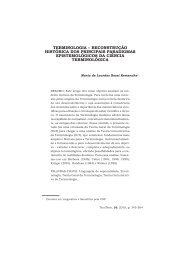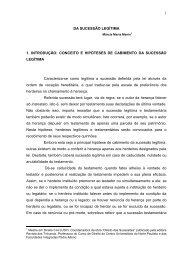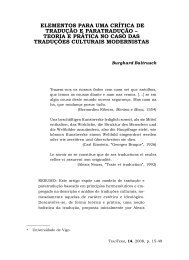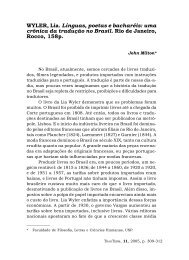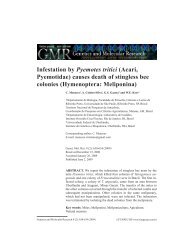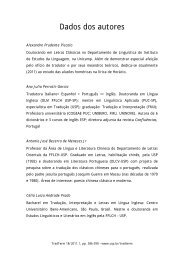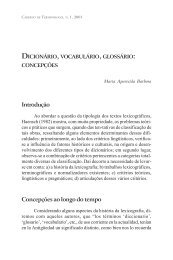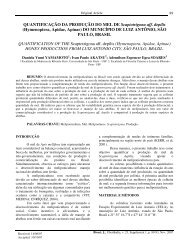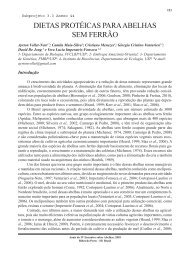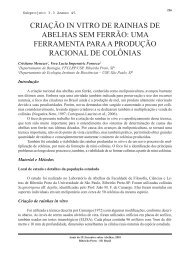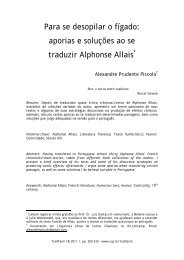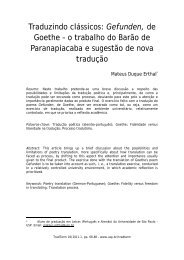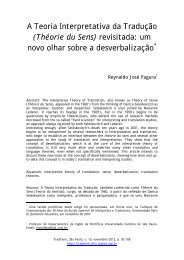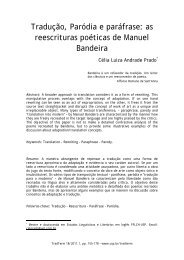Bees as pollinators in Brazil - USP
Bees as pollinators in Brazil - USP
Bees as pollinators in Brazil - USP
Create successful ePaper yourself
Turn your PDF publications into a flip-book with our unique Google optimized e-Paper software.
• there is a need for improved pest management<br />
so that <strong>in</strong>secticide sprays are not<br />
applied dur<strong>in</strong>g bloom<strong>in</strong>g periods;<br />
• there is a lack of knowledge of techniques<br />
and species' potential to produce bees <strong>in</strong><br />
large numbers;<br />
• there is a lack of knowledge of what crops<br />
benefit most from poll<strong>in</strong>ation by solitary bees;<br />
• agricultural lands lack marg<strong>in</strong>s/fallow/<br />
hedgerow are<strong>as</strong> for ground<strong>in</strong>g nest<strong>in</strong>g bees;<br />
• we need good methods for field <strong>as</strong>sessment<br />
of poll<strong>in</strong>ation value;<br />
• affordable nest<strong>in</strong>g materials/trap nests<br />
need to be developed and made available,<br />
b<strong>as</strong>ed on knowledge of which bees are<br />
go<strong>in</strong>g to be used;<br />
Workshop I 57<br />
• there is a lack of taxonomic pollen analysis or<br />
floral visitation analysis to establish floral use.<br />
Other ma<strong>in</strong> recommendations are to compile<br />
<strong>Brazil</strong>ian studies of p<strong>as</strong>t trap-nest<strong>in</strong>g experience<br />
<strong>in</strong> <strong>Brazil</strong> and produce a start<strong>in</strong>g po<strong>in</strong>t for<br />
those species that are present <strong>in</strong> the country<br />
and can be reared <strong>in</strong> trap-nests. It is also important<br />
to develop an <strong>in</strong>secticide management<br />
program, <strong>in</strong> which pest control practices should<br />
m<strong>in</strong>imize bee mortality (label requirements on<br />
<strong>in</strong>secticides, for <strong>in</strong>stance, should emph<strong>as</strong>ize<br />
scout<strong>in</strong>g and economic thresholds). This program<br />
could be developed by the honey bee<br />
management group due to their greater experience<br />
<strong>in</strong> us<strong>in</strong>g bees for poll<strong>in</strong>ation purposes.<br />
Some cultivated plants that probably benefit from poll<strong>in</strong>ation by solitary bees.<br />
Botanic Family<br />
Apocynaceae<br />
Anacardiaceae<br />
Bixaceae<br />
Cucurbitaceae<br />
Fabaceae<br />
Lecythidaceae<br />
Scientific name<br />
Hancornia speciosa<br />
Anacardium occidentale<br />
Spondi<strong>as</strong> tuberosa<br />
Spondi<strong>as</strong> spp<br />
Bixa orellana<br />
Cucurbita pepo<br />
Cucurbita moschata<br />
Cucumis melo<br />
Cucumis sativus<br />
Glyc<strong>in</strong>e max<br />
Vicia faba<br />
Ph<strong>as</strong>eolus vulgaris<br />
Lens esculenta<br />
Pisum sativum<br />
Vigna s<strong>in</strong>ensis<br />
Bertholletia excelsa<br />
Common names -<br />
English<br />
c<strong>as</strong>hew<br />
pumpk<strong>in</strong><br />
squ<strong>as</strong>h<br />
melon<br />
cucumber<br />
soybean<br />
field bean<br />
kidney bean<br />
lentils<br />
pea<br />
cowpea<br />
<strong>Brazil</strong> nut<br />
Common names -<br />
Portuguese<br />
Mangaba<br />
Caju<br />
Umbu<br />
Caja, Cajarana, Umbu-caja<br />
Urucum, Coloral, Açafrão<br />
Moranga<br />
Abóbora<br />
Melão<br />
Pep<strong>in</strong>o<br />
Soja<br />
Feijão<br />
Lentilha<br />
Ervilha<br />
Feijão de corda<br />
C<strong>as</strong>tanha do Pará



